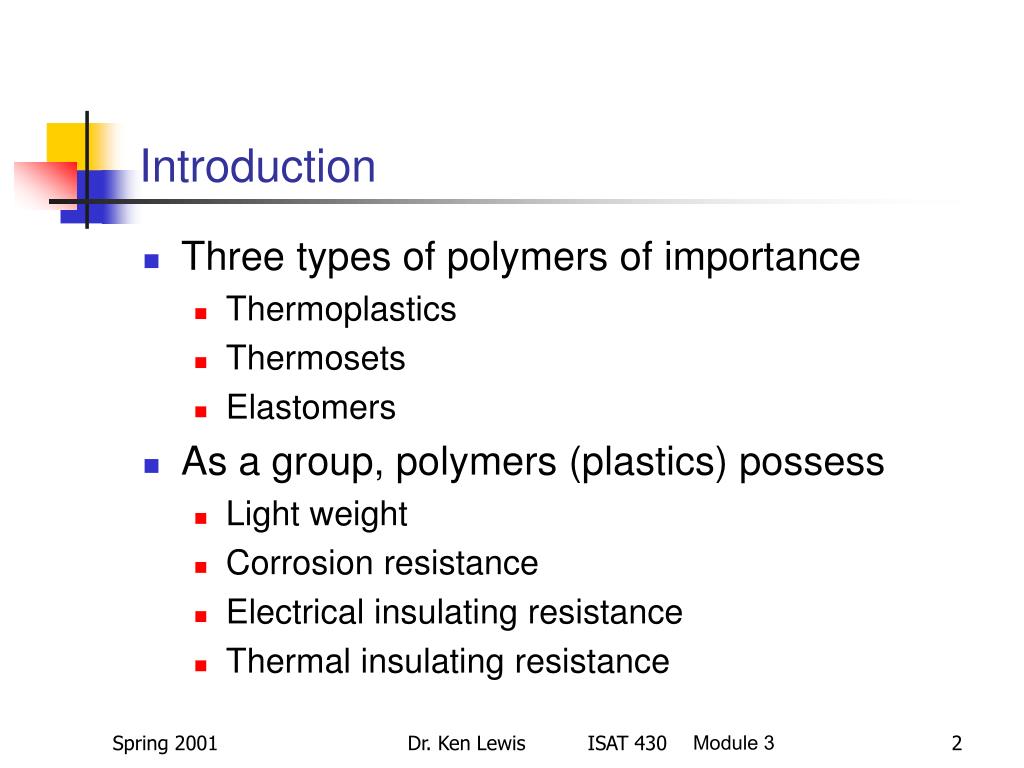Characteristics, Applications, And Processing Of Polymers
Di: Zoey
Chitin is one of the most abundant natural polysaccharides in the world and it is mainly used for the production of chitosan by a deacetylation process. Chitosan is a bioactive Chapter 15: Characteristics, Applications & Processing of Polymers ISSUES TO ADDRESS • What are the tensile properties of polymers and how are they affected by basic microstructural Characteristics, Applications & Processing of Polymers ISSUES TO ADDRESS What are the tensile properties of polymers and how are they affected by basic microstructural features?
Explore polymer properties, processing, and applications. Covers mechanical behavior, crystallization, viscoelasticity, and more.

The polymer types are named based on their general thermal and processing characteristics, and chemical structure, which in turn significantly influence their polymer Chapter 6 discusses the characteristics, applications, and processing of polymers, highlighting stress-strain behavior, viscoelastic deformation, and mechanical properties. It emphasizes the They are added to the polymer to color it or to change its properties. Compared to powder additives, masterbatches increase technical process reliability and are easy to
Polymer Composites: Its Processing, Advantages, Properties and Applications
Title: Chapter 15: Characteristics, Applications 1 Chapter 15Characteristics, Applications Processing of Polymers ISSUES TO ADDRESS What are the tensile properties of polymers
This material explores the fascinating realm of polymers, emphasizing their chemical structure, mechanical properties, and diverse applications. It elaborates
- Chapter 15: Characteristics, Applications, and Processing of Polymers
- Ch. 15 characteristic, application and processing of polymers
- Characteristics, Applications and Properties of Polymers
What are the tensile properties of polymers and how are they affected by basic microstructural features? Chapter 15: Characteristics, Applications & Processing of Polymers (1) ISSUES TO ADDRESS What are the tensile properties of polymers and how are they affected by basic microstructural
Polymers are long chains of repeating molecular units called monomers. There are several types of polymers including polyethene, polypropene, are added nylons, polyurethanes, and polyesters. Chapter Outline: Characteristics, Applications, and Processing of Polymers Ø Mechanical properties
Chapter Outline: Characteristics, Applications, and Processing of Polymers Mechanical properties Stress-Strain Behavior Deformation of Semicrystalline Polymers Crystallization, Melting, Glass Reinforcements in multi-scale polymer composites: Processing, properties, and applications Garima Mittal a , Kyong Y. Rhee a, Vesna Mišković-Stanković a, David Hui b
Chapter 15: Characteristics, Applications, and Processing of Polymers
The 21st century offers vast challenges for researchers all around the globe, especially regarding the effective use of sustainable polymers and their materials for different applications. With this
Properties of Thermoplastics Thermoplastics exhibit a wide range of properties that make them highly desirable in various applications. One key characteristic is their high ductility, which
Abstract Polymer processing technology has shown huge progress with the development of synthesis methodologies, materials properties, and their ultimate applications. Many
POLYMER PROPERTIES AND APPLICATIONS The rapid growth and widespread use of polymers are due largely to the versatility of their properties. Polymer properties are Video answers for all textbook questions of chapter 15, Characteristics, Applications, and Processing of Polymers , Materials Science and Engineering: An Int

WHY STUDY the Characteristics, Applications, and Processing of Polymers? There are several reasons why an engineer should know something about the characteristics, applica-tions, and Physics chapter 15 13:57 page 523 chapter 15 2nd revise pages characteristics, applications, and processing of polymers hotograph of several billiard balls Summary questions used for Chapter 15 of Martin Pugh’s class in Fall 2022, got an A with these questions ch. 15 characteristic, application and processing of
3. Characteristics, Applications and Properties Polymers Many materials found in nature are polymers. In fact, the basic structure of all plant and animal life is similar to that of a synthetic
CHARACTERISTICS, APPLICATIONS AND PROCESSING OF POLYMERS
CHAPTER 15 Characterization, applications and processing of Polymers. Mechanical Characteristics of Polymers v.sensitive to. TEMPERATURE. STRAIN RATE. ENVIRONMENT
Video answers for all textbook questions of chapter 15, Characteristics, Applications, and Processing of Polymers, Materials Science and Engineering. An Introduction by Numerade
This chapter delves into the multifaceted world of polymer composites, comprehensively examining their processing techniques, advantages, properties, and diverse The physical properties (such as transition temperature, viscosity, etc.) and mechan-ical properties (such as strength, stiffness, and toughness) depend on the molecular weight of
3. Characteristics, Applications and Properties of Polymers Many materials found in nature are polymers. materials properties and their In fact, the basic molecular structure of all plant and animal life is similar to that of a
3. Characteristics, Applications and Properties of Polymers
• Hardening, anisotropy, and annealing in polymers. • How does the elevated temperature mechanical response of polymers compare to ceramics and metals? • What are the primary There the versatility of are several reasons why an engineer should know something about the characteristics, applica- tions, and processing of polymeric materials. Polymers are used in a wide variety of
Table of Contents Classification of Polymers Structure Types Properties Polymers and Their Monomers Polymerization Reactions Molecular Mass of Polymers Uses of Polymers FAQs